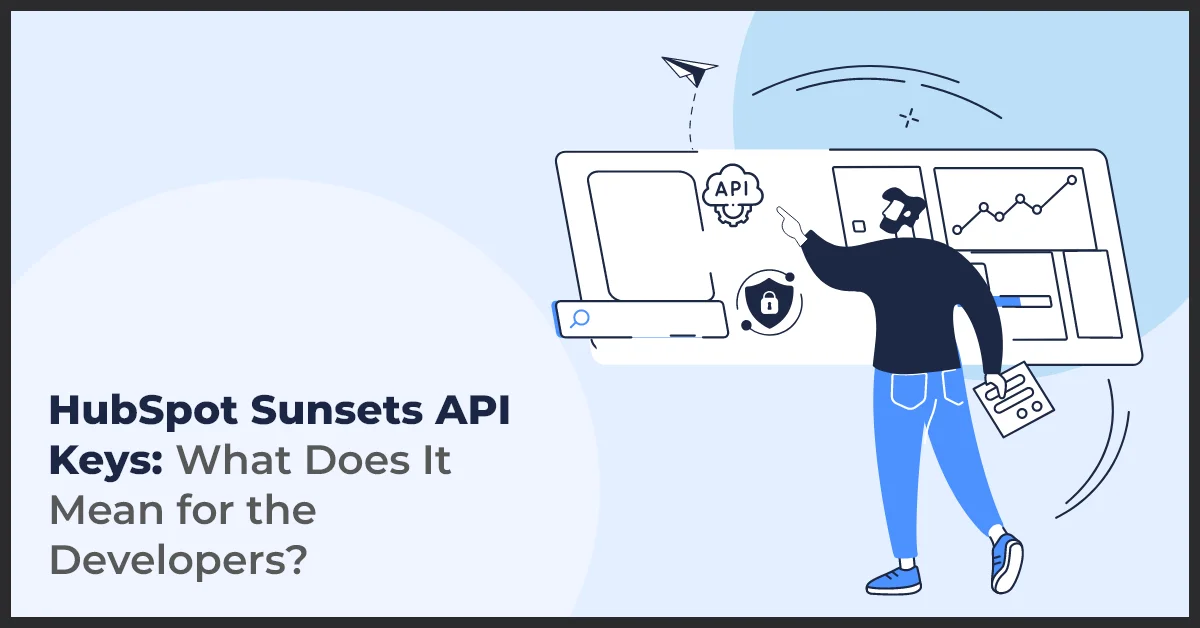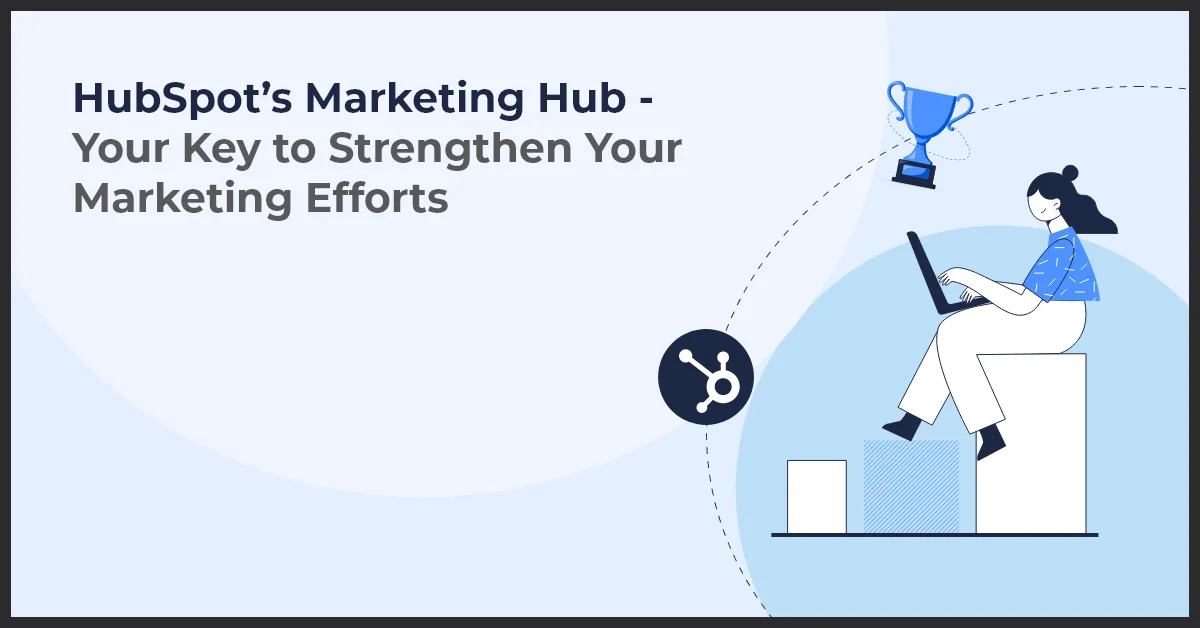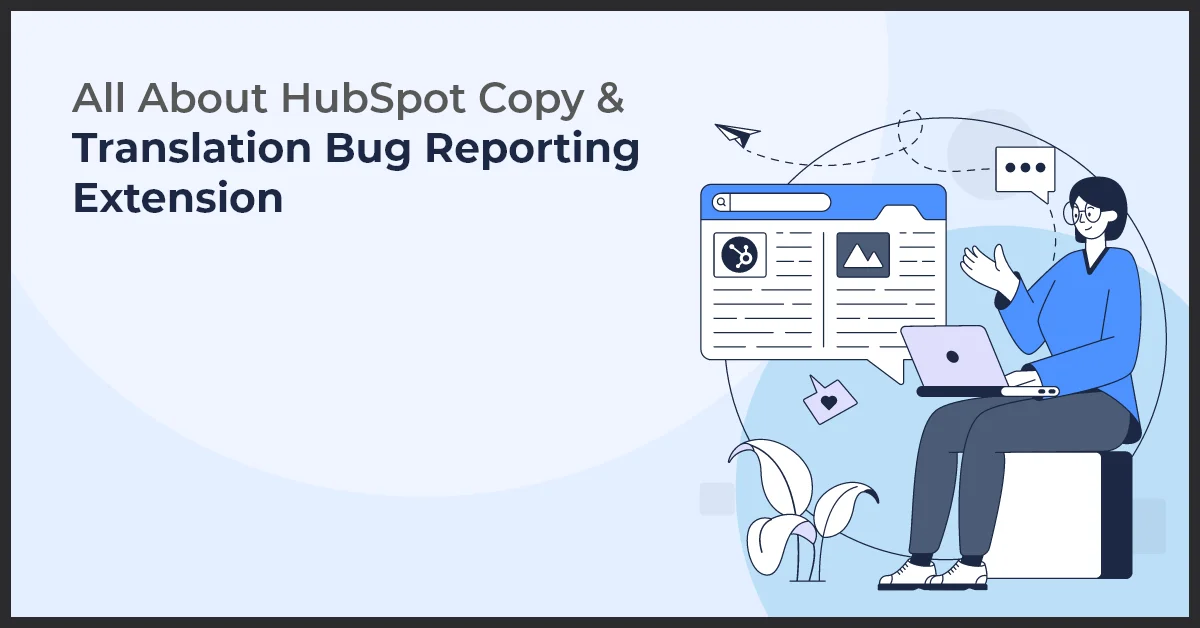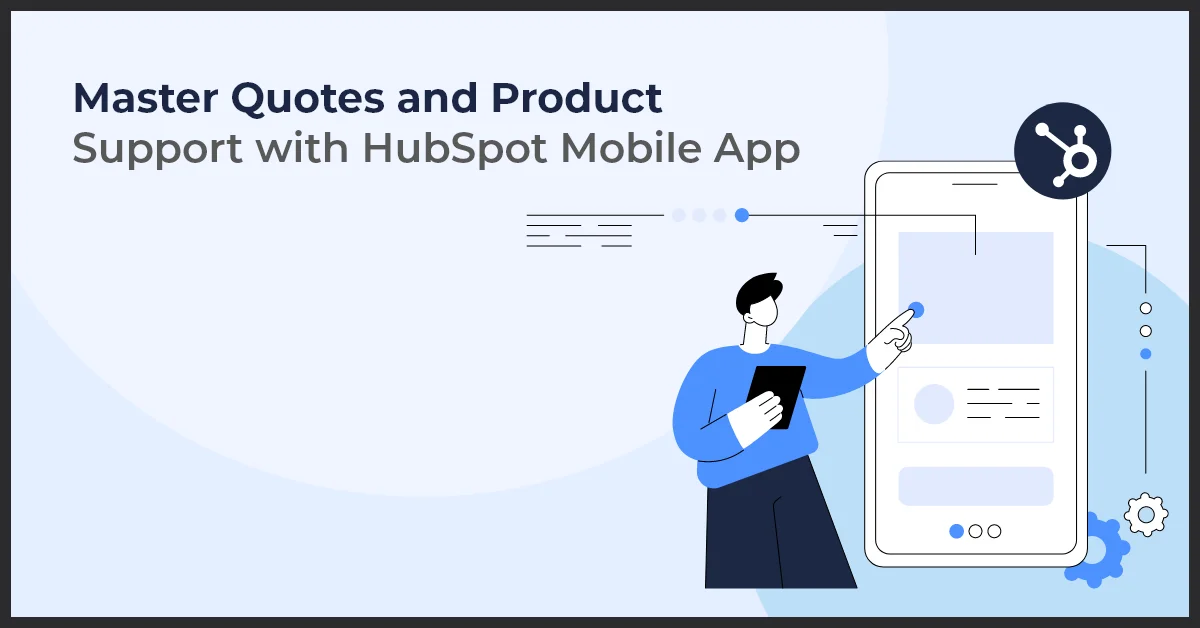HubSpot Sunsets API Keys: What Does It Mean for the Developers?

Published on: November 7, 2022
Updated on: July 11, 2024
648 Views
- HubSpot
18 min read
API keys have been one of the three methods of authentication on HubSpot among OAuth and private app access tokens. As a part of ongoing effort to boost cybersecurity and protect customers’ data, HubSpot has decided to sunset the API keys. Yes that’s correct, HubSpot announced on June 1, 2022 that it will phase out API keys by November 30, 2022.
Businesses will now need alternate solutions for authenticating and authorizing applications and their custom integrations, such as, private apps. In this blogpost we will explore what does API keys sunset means for you, why the change, and what you need to do. But first,
What Are HubSpot API Keys?
Application programming interfaces or APIs allow software programs to communicate, share data and integrate their functionalities with each other. API’s facilitate conversations between disconnected software. But unlike face-to-face conversation it is difficult for an API to verify whether it is talking to who it claims to be. This is where API keys step in.
HubSpot API keys enable account security by automatically identifying and authorizing projects and applications, while limiting API access to those with an API key. In other words, API keys act like an ID card for the client making an API request, helping APIs assign complete access permissions to measure and track how their data is being used.
The only drawback of using API keys is that they function like passwords. If a hacker were to get his hands on your API key, they will have access to your sensitive data and personal information. This is one of the reasons why HubSpot decided to make the move of removing API keys.
Understanding HubSpot API Key
API stands for Application Programming Interface. It is a set of protocols and tools that allows different software applications to communicate and interact with each other. APIs are essential for data integration and communication between various platforms and systems.
The HubSpot API Key is a unique code that is generated for each user or developer in the HubSpot ecosystem. It serves as a secure and authenticated way to access and manipulate HubSpot data through the API.
One of the key benefits of using the HubSpot API Key is the ability to access and manipulate HubSpot data programmatically. This means that developers can use the API Key to automate tasks, retrieve data, update information, and perform various operations within the HubSpot platform.
Using the API Key also enables developers to integrate HubSpot with other systems and applications, creating powerful cross-platform solutions. This integration allows for seamless data synchronization, streamlining processes, and enhancing productivity.
Additionally, the API Key provides developers with granular control over access to HubSpot data. It allows them to define permissions and access levels, ensuring data security and privacy. This level of access control is crucial for companies that handle sensitive information and want to limit data exposure.
In conclusion, the HubSpot API Key is an essential tool for developers who want to leverage the power of HubSpot's ecosystem. It provides a secure and authenticated way to access and manipulate HubSpot data, enabling integrations, automations, and customized applications.
Overview of HubSpot Integration
Integrating HubSpot with other systems can greatly enhance the capabilities of your marketing and sales efforts. By connecting HubSpot with your CRM, customer support software, and other tools, you can streamline processes and gain valuable insights into your customer's journey.
With the HubSpot API Key, you have the power to seamlessly integrate HubSpot with third-party applications. This key acts as the gateway, providing secure access to HubSpot's API and enabling data flow between different systems in real-time.
By leveraging HubSpot integration capabilities, you can save time, improve efficiency, and automate repetitive tasks. No more manual data entry or switching between different platforms - everything can be managed from one central hub.
Integrating HubSpot with other systems offers numerous advantages. Firstly, it allows you to have a holistic view of your customers by syncing data across platforms. This means that your marketing, sales, and customer support teams all have access to the same up-to-date information.
Additionally, integration enables you to better nurture leads and personalize communication. For example, you can trigger automated email campaigns based on specific actions taken by a lead in your CRM or send targeted messages based on their support history.
The API Key is the key to this integration magic. It authenticates your access and ensures that data is securely transmitted between systems. With this key, you can effortlessly connect HubSpot with your favorite tools, such as your CRM, CMS, or e-commerce platform.
In summary, HubSpot integration is a game-changer for businesses looking to centralize their operations and optimize their customer journey. With the API Key, you can unlock the full potential of HubSpot's capabilities and create a seamless experience for your team and customers alike.
HubSpot API Key for Developers
Developers play a crucial role in utilizing the HubSpot API Key to its full potential. With the API Key, developers have the power to create custom applications that seamlessly integrate with HubSpot's robust CRM and marketing automation platform.
One of the main advantages of using the HubSpot API Key as a developer is the ability to create custom applications. Developers can leverage the API Key's functionalities to build tailor-made applications that meet the specific needs of businesses and users. Whether it's automating repetitive tasks, integrating with third-party tools, or extracting valuable data, the possibilities are endless.
Now, let's delve into some examples of the types of applications developers can build using the HubSpot API Key:
- Lead Generation and Management Applications: Developers can create applications that generate leads from various sources and automatically add them to HubSpot's CRM. These applications can help businesses streamline their lead management process and improve conversion rates.
- Marketing Automation Applications: With the HubSpot API Key, developers can build applications that automate marketing tasks such as email campaigns, social media scheduling, and personalized content delivery. These applications empower businesses to reach their target audience effectively and nurture leads.
- Data Analytics and Reporting Applications: By utilizing the HubSpot API Key, developers can create applications that extract and analyze data from HubSpot's CRM and marketing tools. These applications enable businesses to gain valuable insights, enhance decision-making, and measure the success of their marketing campaigns.
These are just a few examples of the limitless possibilities developers have with the HubSpot API Key. By harnessing their coding expertise and leveraging the API Key's functionalities, developers can revolutionize the way businesses interact with HubSpot's platform.
API Authentication and Access Control
API authentication is a crucial aspect of ensuring data security when using the HubSpot API Key. By providing a secure way to authenticate and authorize access to your HubSpot data, API authentication prevents unauthorized access and protects sensitive information.
HubSpot employs various mechanisms for API authentication, including OAuth 2.0, API keys, and single sign-on. In this section, we will focus on how API authentication works using API keys.
How API Authentication Works in HubSpot
API keys provide a simple and effective way to authenticate access to the HubSpot API. When making API requests, you include your API key in the Authorization header of the HTTP request. This key acts as a unique identifier for your application, allowing HubSpot to verify your authorization to access specific resources.
API keys in HubSpot follow a role-based access control (RBAC) approach, meaning you can assign different levels of access permissions to different keys. This allows you to control which parts of your HubSpot account and data are accessible through the API.
Generating and Managing API Keys for Secure Access
To generate an API key in HubSpot, follow these simple steps:
- Log in to your HubSpot account and navigate to "Settings."
- Click on "Integrations" and then select "API key."
- Click on "Create API key" and provide a name for your key.
- Choose the required access permissions for the key.
- Click "Create" to generate the API key.
Once you have generated an API key, it's crucial to securely manage and protect it. Treat your API key as a sensitive piece of information and avoid sharing it publicly or storing it in an insecure location. HubSpot also provides options to revoke or regenerate API keys if needed.
By following these steps, you can ensure secure and controlled access to your HubSpot data through the API, minimizing the risk of unauthorized access or data breaches.
Webhooks and Event Notifications
Introduction to webhooks and their significance in real-time data synchronization
Webhooks are a powerful tool that allows applications to receive real-time notifications when certain events occur. In the context of HubSpot, webhooks enable developers to stay synchronized with the latest updates and changes happening within their HubSpot account.
By utilizing webhooks, developers can receive immediate notifications about important events, such as when a new contact is created, a deal is closed, or a form is submitted. This real-time data synchronization ensures that developers can always have access to the most up-to-date information.
How developers can utilize HubSpot API Key to set up webhooks for event notifications
Setting up webhooks with the HubSpot API Key is a straightforward process that empowers developers with the ability to integrate their applications seamlessly with HubSpot. Here are the steps to get started:
- Retrieve your HubSpot API Key from your HubSpot account.
- Create a webhook endpoint within your application to receive the event notifications.
- Using the HubSpot API, configure the webhook URL and specify the events that you are interested in listening to.
- Test the webhook functionality by triggering the specified events in HubSpot and verify that your application receives the notifications.
Benefits and applications of webhooks for timely data updates and automation
Webhooks offer numerous benefits and open up a world of possibilities for developers. With webhooks, developers can:
- Keep external systems or databases in sync with HubSpot in real-time.
- Trigger custom actions or workflows based on specific events.
- Automate data synchronization between different applications.
- Integrate HubSpot with third-party platforms for seamless connectivity.
- Update records, send notifications, or perform any other desired action as soon as an event occurs.
Webhooks provide an efficient way to automate processes, reduce manual effort, and ensure accurate and consistent data across various systems.
Data Synchronization and Management
As you dive deeper into the world of HubSpot API Key, you'll discover its powerful capabilities in synchronizing data between systems. Whether it's transferring information from your CRM to HubSpot or vice versa, the API Key allows for seamless data synchronization.
Developers can leverage the API Key to effortlessly manage and manipulate data within HubSpot. With the API, you can create, update, and delete various records such as contacts, companies, deals, and more. This flexibility provides endless possibilities in customizing your data management processes.
Efficient data synchronization and management using the API Key require following best practices. Firstly, it is crucial to establish a solid data model and schema to ensure seamless integration. This involves mapping the fields in your external system to the corresponding fields in HubSpot. This mapping ensures accurate data synchronization and avoids any discrepancies.
Additionally, it is recommended to implement a synchronization strategy that suits your business needs. For instance, you can choose between two-way synchronization, where changes made in both systems are synced, or one-way synchronization, where updates are pushed from one system to another. Assessing your requirements and implementing a robust strategy will ensure data integrity and prevent any data loss.
Furthermore, it is important to schedule regular data synchronization processes to keep your systems updated in real-time. By automating these processes, you can save time and eliminate the risk of human error.
Lastly, monitoring and logging are essential aspects of data management. By monitoring the synchronization processes and logging any errors or inconsistencies, you can quickly identify and resolve any issues that may arise.
In conclusion, the HubSpot API Key is a powerful tool for data synchronization and management. By exploring its capabilities, leveraging it effectively, and adhering to best practices, you can streamline your data operations and ensure accurate and efficient synchronization between systems.
Custom Applications and Integrations
The HubSpot API Key opens up a world of possibilities for developers to create custom applications and integrations that enhance and extend the functionality of HubSpot. With the API Key, you can seamlessly connect HubSpot with other tools and systems, automate processes, and leverage data in new and innovative ways.
Unlocking Potential with the HubSpot API Key
The HubSpot API Key empowers developers to build custom applications that meet specific business needs. Whether you want to create a custom CRM interface, integrate with an e-commerce platform, or synchronize data from multiple sources, the API Key provides the necessary tools and resources to make it happen.
Examples of Successful Custom Applications and Integrations
Many businesses have already unlocked the power of the HubSpot API Key to create unique and tailored solutions. For example, a marketing agency developed a custom integration that automatically imports leads from an external CRM into HubSpot, streamlining their lead generation process.
Another company built a custom application that pulls customer data from HubSpot and displays it in real-time on their website, allowing their sales team to provide a personalized experience to potential customers.
Tips for Developers
If you're a developer looking to leverage the HubSpot API Key, here are some tips to help you get started:
- Understand the business needs: Before diving into development, ensure you have a clear understanding of the specific requirements and goals of the application or integration you're building.
- Explore the API documentation: Familiarize yourself with the available APIs, endpoints, and data models to determine the best approach for your project.
- Use webhooks for real-time updates: Take advantage of webhooks to receive instant notifications about events and changes happening in HubSpot, allowing your application to stay in sync with the latest data.
- Test, test, test: Thoroughly test your application or integration to ensure it functions as intended and handles errors gracefully.
By following these tips, you'll be able to utilize the HubSpot API Key effectively and build powerful custom applications and integrations that drive business growth.
API Documentation and Support
As a developer, having access to comprehensive API documentation is crucial. It allows you to understand the capabilities and limitations of the HubSpot API Key and empowers you to build robust applications and integrations.
HubSpot provides a range of well-documented resources to assist developers in their API journey. The API documentation includes detailed descriptions of endpoints, request parameters, response formats, and examples to facilitate seamless integration.
Additionally, HubSpot offers several libraries and SDKs in popular programming languages, making it easier for developers to utilize the API effectively.
For quick and efficient troubleshooting, HubSpot's support team is readily available to assist you. Whether you encounter technical issues, require guidance, or have questions related to the HubSpot API Key, the support team can provide expert advice and solutions.
Furthermore, HubSpot offers a dedicated community forum where developers can connect with peers, discuss API-related challenges, and share knowledge. This collaborative space allows you to learn from others' experiences and stay up-to-date with the latest developments.
In conclusion, HubSpot understands the importance of API documentation and support for developers using the HubSpot API Key. By providing comprehensive documentation and accessible support channels, HubSpot enables developers to create powerful integrations and applications with ease.
How Will This Change Impact Developers?
Once API keys are completely phased out, HubSpot will no longer authenticate custom integrations or those built around API keys. Users who previously developed using API keys will now be required to migrate existing integrations from API keys to private apps or HubSpot Public Apps using OAuth 2.0 instead.
Why This Change? - Increased Security Through Private and Public Apps
Unlike API keys where all HubSpot integrations share the same password, private and public apps allow you to set up distinct and separate static access tokens for each integration. Private access tokens are also scoped so that you can control access to each integration to your HubSpot account. This gives you a greater control over how users access and process business data.
Private apps are not much different from API integrations. The only main difference is that they use a static access token in the authorization HTTP header instead of the API request using a query parameter to authorize API request. In simpler terms it is the difference between giving all users super admin access , as in API keys, and selecting user permissions and privileges, as in private and public apps.
Private apps are mostly used for a single HubSpot account on the other hand you can use public apps for multiple HubSpot accounts.
Migrate Existing App Integrations to Private Apps
Your API key provides both read and write access to your HubSpot CRM data. This can pose a security risk if your API key is compromised. By switching to a private app, you may approve the precise scopes that your integration needs, creating an access token that restricts the information that your integration can access or modify in your account.
Follow these steps to migrate your existing app integrations:
- Create a Private App
- Click the settings icon in the main navigation bar of your HubSpot account.
- Go to Integrations > Private Apps in the menu on the left.
- Click on create a private app
- Configure the information about your app on the Basic Info tab:
- Name your application now.
- To upload a square picture that will be used as the logo for your app, hover your cursor over the placeholder logo and click the upload icon.
- Give your app a description here.
- On the Scopes tab, click.
- Then, based on the APIs that your integration utilizes, choose the scopes to authorize. Which scopes your app needs can be determined by:
- List the HubSpot APIs that your current integration utilizes.
- Navigate to the relevant developer documentation for each API request (the contacts API).
- Scroll to the endpoint that your integration uses, then click the Endpoints tab.
- Find the scopes needed to use the endpoint under the Requirements section. You should choose the scopes indicated under Granular scopes whenever possible instead of those listed under Standard scopes. If no granular scopes are listed, it is better to use the standard scopes.
- Select the Read or Write checks next to the appropriate scopes in the private app's settings. Using the Find a scope search field, you may also look for a scope.
- Click Create app in the top right when you have finished choosing your scopes. After you've created your app, you can always make modifications to it.
- Review the information regarding the access token for your app in the dialogue box, then click Continue Creating.
With a new private app created, you can start making API requests using access tokens.
- Update the Authorization Method of Your Integration's API Request
- Private app access tokens are included in the Authorization header of your request instead of a hapiKey query parameter. Set Bearer YOUR_ACCESS_TOKEN as the Authorization header value when submitting a request.
- You can use one of HubSpot's client libraries to make authorized calls with your access token because private app access tokens are implemented on top of OAuth.
- Remove all citations to the HubSpot API key from your code and switch to using your private app's access token as described above to finish the migration to your private app.
- Instead of hard coding your token into your queries, you might prefer to establish a secret to store it, depending on the request you're making.
- When using a token in a serverless method, for instance, using a secret will stop your token from being made public.
- Verify Requests and Monitor Logs
- No other code alterations are necessary after you've deleted all references to the HubSpot API key and changed them to references to your private app's access token.
- Monitor your private apps’ APIs call logs and make sure that none of them returned 400 error messages.
Conclusion: Don’t Let the Sun Set for Your HubSpot Account
Businesses using custom integrations with API keys have until November 30, 2022, to ensure that they are not affected in any way by HubSpot sunsetting API keys. You have two options: either migrate your keys yourself or have a HubSpot Platinum solutions partner do it for you.
Our experts at Growth Natives have experience creating custom integrations for your HubSpot account and successfully ensured data confidentiality for our customers with our innovative techniques. If you would like to know more information, you can talk to us at info@growthnatives.com.
Frequently Asked Questions
In HubSpot, an API key is a unique identifier that is used to authenticate and authorize requests made to the HubSpot API. API keys are used to control access to the API and ensure that only authorized users and applications can interact with HubSpot data.
A developer API key is similar to an API key but is specifically used by developers to access and test APIs during the development process. Developer API keys are often used to access APIs that are still in development or are not yet publicly available.
API keys provide several benefits, including:
- Authentication: API keys are used to authenticate and authorize access to APIs, ensuring that only authorized users and applications can access data.
- Security: API keys can help protect APIs from unauthorized access and misuse.
- Rate limiting: API keys can be used to enforce rate limits on API requests, preventing abuse and ensuring fair usage.
- Monitoring and analytics: API keys can be used to track and monitor API usage, helping developers understand how their APIs are being used and identify any issues.
In cloud endpoints, API keys are used to authenticate requests made to cloud-based APIs. API keys serve as a way to identify the source of a request and ensure that it is coming from a trusted source. API keys can also be used to enforce access control policies and track usage of cloud endpoints.



